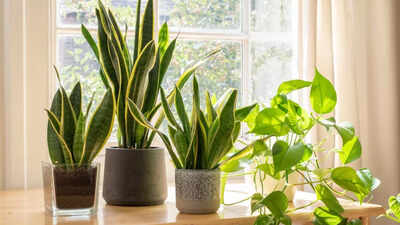ARTICLE AD BOX

Snake plants (Dracaena trifasciata), often known for their striking upright leaves and low-maintenance nature, are among the most popular indoor plants worldwide. Hardy, drought-tolerant, and air-purifying, they thrive in a wide range of home environments, making them perfect for both beginners and seasoned plant lovers.
However, even these tough houseplants require proper care to stay truly healthy and vibrant. From watering techniques to lighting preferences and pest prevention, a few simple adjustments can make a big difference. In this guide, we’ll walk you through 10 essential care tips to help your indoor snake plant flourish for years to come.
How to grow a healthy snake plant indoors: 10 essential care tips
Pick the right pot and soil
Proper drainage is essential for a healthy snake plant. Always use a pot with drainage holes to prevent water from accumulating at the bottom, which can cause root rot.
Terracotta pots are a great option, as their porous material helps wick away excess moisture and keeps the roots drier between waterings.Use fast-draining soil. A cactus or succulent potting mix works best. You can also create your own by combining:
- 2 parts all-purpose potting soil
- 1 part coarse sand
- 1 part perlite
Avoid moisture-retaining soil blends, as they hold water too long and can cause root issues.
Water sparingly and strategically
Snake plants are highly drought-tolerant and generally prefer underwatering to overwatering.
To keep the plant healthy, always allow the top 2–3 inches of soil to dry out completely before watering again. This helps prevent root rot and other moisture-related issues.During the spring and summer, you can water your snake plant roughly once every 2–4 weeks, depending on indoor humidity and light levels. In autumn and winter, when the plant’s growth slows, reduce watering to once every 4–6 weeks, or even less if your space is cool and dry.Signs of overwatering include yellow, mushy leaves, a foul odour from the soil, and a soft or collapsing base. On the other hand, underwatering may cause the leaves to become wrinkled, curled, or develop dry, crispy edges. Monitoring soil moisture and adjusting your routine with the seasons is key to keeping your snake plant thriving.
Find the perfect lighting
Snake plants are versatile and can survive in low light, but they grow best in bright, indirect sunlight.Best locations include:
- Near a north- or east-facing window
- Under filtered sunlight (curtains help soften strong light)
- Beneath artificial grow lights if your home lacks natural light
Avoid harsh direct sunlight, which can burn the leaves, or placing it in dark corners, which can stunt growth. Rotate the plant every few weeks for balanced light exposure.
Keep temperature and humidity in check
Snake plants enjoy warmth and do best in typical indoor conditions.
- Ideal temperature range: 16–29°C (60–85°F)
- Avoid: Cold drafts, frosty windowsills, or heat vents
- Humidity: Normal indoor humidity (30–50%) is fine; no misting required
Never let your plant sit below 10°C (50°F), as cold can damage the foliage.
Feed during the growing season
While snake plants are not heavy feeders, occasional fertilising can encourage healthier growth and more vibrant foliage.
Use a balanced liquid houseplant fertiliser, such as a 10-10-10 formula, diluted to half strength to avoid overfeeding. The ideal time to fertilise is every 4–6 weeks during the growing season, which spans from spring to early autumn. Feeding should be completely avoided in winter, as the plant’s growth naturally slows.
Over-fertilising can lead to root damage or cause the plant to grow weak and leggy, so moderation is key.
Clean the leaves
Dust can collect on your snake plant’s leaves, reducing its ability to absorb light and purify air. Wipe each leaf gently with a damp cloth. Avoid leaf-shine products; they can clog the plant’s pores.
Repot every few years
Snake plants like being slightly root-bound but still need fresh soil and room to grow. When to repot:
- Every 2–3 years
- Roots are pushing out of drainage holes
- Soil becomes compacted and drains poorly
- Choose a pot just 1–2 inches wider and replace the old mix with fresh, well-draining soil.
Watch out for pests and disease
If your snake plant shows signs of pest infestation such as mealybugs, spider mites, or fungus gnats, prompt action is essential.
Wipe the affected areas gently with neem oil, insecticidal soap, or a cotton swab dipped in rubbing alcohol to control and eliminate the pests without harming the plant.In terms of disease, two common issues to watch for are root rot, which occurs due to overwatering, and fungal leaf spots, which can develop in overly humid or poorly ventilated environments. Ensuring proper drainage, avoiding waterlogged soil, and maintaining good air circulation will help prevent these problems and keep your snake plant healthy.
Propagate to grow more
If you're looking to expand your snake plant collection, propagation offers a simple and effective approach. The most reliable method is division, which involves separating mature root clumps during repotting and replanting them into individual containers. Another option is leaf cuttings in water, cut a healthy leaf and place the base in a glass of clean water, allowing roots to form over several weeks. Alternatively, you can try leaf cuttings in soil by cutting the leaf into segments and planting them upright in a moist, well-draining mix.
Though the process requires patience, propagation is a rewarding way to multiply your plants or share them with others.
Style it your way
Snake plants suit nearly every home or office setting.Decor ideas:
- Use minimalist pots for a modern look
- Pair with trailing plants for visual contrast
- Place tall varieties like ‘Laurentii’ in empty corners
- Use short varieties like ‘Hahnii’ on shelves or desks
A thriving snake plant isn’t just a beautiful houseplant—it also supports better indoor air and adds a calming presence to any space. Treat it well, and it’ll reward you with years of elegant, fuss-free greenery.Also Read: Why Amaranth is a must-have plant for every home gardener and how to grow it



.png)
.png)
.png)
















 15 hours ago
5
15 hours ago
5









 English (US) ·
English (US) ·